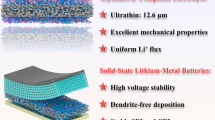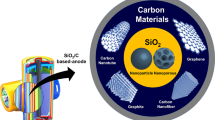Abstract
The inherent disadvantages of untreated carbon felt (pristine-CF) still restrict the vanadium redox flow battery (VRFB) from further improving in electrochemical performances. To solve this problem, the carbon felt (CF) decorated with bismuth hydrogen edetate (Bi(HEDTA)) complex was synthesized and studied as anode for VRFB. The cyclic voltammetry curve reflects the great improvement in electrochemical reversibility by reducing the peak potential difference from 0.73 to 0.50 V. Electrochemical impedance spectrum shows the better charge transfer process by reducing the charge transfer resistance from 7.14 to 1.13 Ω. The VRFB assembled by the CF modified with Bi(HEDTA) exhibits an energy efficiency of 66.25% at a current density of 160 mA cm−2, which is 11.76% higher than that of the pristine system. Moreover, the mechanism of Bi(HEDTA) involved in the anodic half-reaction of VRFB has been put forward. The results demonstrate that not only the metal but also the ligand of the complex are significant for improving the electrochemical activity of the reaction towards V3+/V2+ redox couple. In more detail, the oxygen-containing functional groups in the ligand could increase the wettability of the CF as well as act as the active sites, and the metal could decrease the evolution of hydrogen at the same time. Therefore, the effective combination of the respective functions of ligand and metal, makes Bi(HEDTA) a feasible ornament of the CF for VRFB.








Similar content being viewed by others
References
Shi L, Liu S, He Z, Yuan H, Shen J (2015) Synthesis of boron and nitrogen co-doped carbon nanofiber as efficient metal-free electrocatalyst for the VO2+/VO2 + redox reaction. Electrochim Acta 178:748–757
Huang P, Ling W, Sheng H, Zhou Y, Wu X, Zeng X, Wu X, Yu G (2018) Heteroatom-doped electrodes for all-vanadium redox flow batteries with ultralong lifespan. J Mater Chem A 6(1):41–44
Yang Z, Zhang J, Kintner-Meyer M, Lu X, Choi D, Lemmon J, Liu J (2011) Electrochemical energy storage for green grid. Chem Rev 111(5):3577–3613
He X, Sun Z, Zou Q, Wu L, Jiang J (2019) Electrochemical behavior of Co(II) reduction for preparing nanocrystalline Co catalyst for hydrogen evolution reaction from 1-ethyl-3-methylimidazolium bisulfate and ethylene glycol system. J Electrochem Soc 166:D57–D64
Jiang Z, Li Y, Zhu J, Li B, Li C, Wang L, Meng W, He Z, Dai L (2019) Synthesis and performance of a graphene decorated NaTi2(PO4)3/C anode for aqueous lithium-ion batteries. J Alloys Compd 791:176–183
Koroneos C, Spachos T, Moussiopoulos N (2003) Exergy analysis of renewable energy sources. Renew Energy 28:295–310
Liu Y, Shen Y, Yu L, Liu L, Liang F, Qiu X, Xi J (2018) Holey-engineered electrodes for advanced vanadium flow batteries. Nano Energy 43:55–62
Suarez DJ, Gonzalez Z, Blanco C, Granda M, Menendez R, Santamaria R (2014) Graphite felt modified with bismuth nanoparticles as negative electrode in a vanadium redox flow battery. ChemSusChem 7(3):914–918
Li J, Liu S, He Z, Zhou Z (2017) A novel branched side-chain-type sulfonated polyimide membrane with flexible sulfoalkyl pendants and trifluoromethyl groups for vanadium redox flow batteries. J Power Sources 347:114–126
He Z, Jiang Y, Zhu J, Wang H, Li Y, Zhou H, Meng W, Dai L, Wang L (2018) N-doped carbon coated LiTi2(PO4)3 as superior anode using PANi as carbon and nitrogen bi-sources for aqueous lithium ion battery. Electrochim Acta 279:279–288
Zhao K, Liu S, Ye G, Gan Q, Zhou Z, He Z (2018) High-yield bottom-up synthesis of 2D metal- organic frameworks and their derived ultrathin carbon nanosheets for energy storage. J Mater Chem A 6:2166–2175
He Z, Li M, Li Y, Li C, Yi Z, Zhu J, Dai L, Meng W, Zhou H, Wang L (2019) ZrO2 nanoparticle embedded carbon nanofibers by electrospinning technique as advanced negative electrode materials for vanadium redox flow battery. Electrochim Acta 309:166–176
Aaron D, Liu Q, Tang Z, Grim G, Papandrew A, Turhan A et al (2012) Dramatic performance gains in vanadium redox flow batteries through modified cell architecture. J Power Sources 206:450–453
Parasuraman A, Lim T, Menictas C, Skyllas-Kazacos M (2013) Review of material research and development for vanadium redox flow battery applications. Electrochim Acta 101:27–40
Li L, Kim S, Wang W, Vijayakumar M, Nie Z, Chen B, Zhang J, Xia G, Hu J, Graff G, Liu J, Yang Z (2011) A stable vanadium redox-flow battery with high energy density for large-scale energy storage. Adv Energy Mater 1(3):394–400
Liu Y, Liang F, Zhao Y, Yu L, Liu L, Xi J (2018) Broad temperature adaptability of vanadium redox flow battery–part 4: unraveling wide temperature promotion mechanism of bismuth for V2+/V3+ couple. Journal of Energy Chemistry 27(5):1333–1340
Li C, Xie B, Chen J, He J, He Z (2017) Enhancement of nitrogen and sulfur co-doping on the electrocatalytic properties of carbon nanotubes for VO2+/VO2 + redox reaction. RSC Adv 7(22):13184–13190
Shi L, Liu S, He Z, Shen J (2014) Nitrogen-doped graphene:effects of nitrogen species on the properties of the vanadium redox flow battery. Electrochim Acta 138:93–100
Huang Y, Deng Q, Wu X, Wang S (2017) N, O co-doped carbon felt for high-performance all-vanadium redox flow battery. Int J Hydrog Energy 42(10):7177–7185
Etesami M, Abouzari-Lotf E, Ripin A, Mahmoud N, Ting T, Saharkhiz A et al (2018) Phosphonated graphene oxide with high electrocatalytic performance for vanadium redox flow battery. Int J Hydrog Energy 43(1):189–197
Abbas S, Lee H, Hwang J, Mehmood A, Shin H, Mehboob S et al (2018) A novel approach for forming carbon nanorods on the surface of carbon felt electrode by catalytic etching for high-performance vanadium redox flow battery. Carbon 128:31–37
Chang Y, Shih Y, Chen J, Lin G, Hsu N, Chou Y et al (2016) High efficiency of bamboo-like carbon nanotubes on functionalized graphite felt as electrode in vanadium redox flow battery. RSC Adv 6(104):102068–102075
Kabir H, Gyan I, Francis C (2017) Electrochemical modification of a pyrolytic graphite sheet for improved negative electrode performance in the vanadium redox flow battery. J Power Sources 342:31–37
Wu L, Shen Y, Yu L, Xi J, Qiu X (2016) Boosting vanadium flow battery performance by nitrogen-doped carbon nanospheres electrocatalyst. Nano Energy 28:19–28
He Z, Su A, Gao C, Zhou Z, Pan C, Liu S (2012) Carbon paper modified by hydrothermal ammoniated treatment for vanadium redox battery. Ionics 19(7):1021–1026
He Z, Jiang Y, Li Y, Zhu J, Zhou H, Meng W, Wang L, Dai L (2018) Carbon layer-exfoliated, wettability-enhanced, SO3H-functionalized carbon paper: a superior positive electrode for vanadium redox flow battery. Carbon 127:297–304
Han P, Wang H, Liu Z, Chen X, Ma W, Yao J, Zhu Y, Cui G (2011) Graphene oxide nanoplatelets as excellent electrochemical active materials for VO2+/VO2 + and V2+/V3+ redox couples for a vanadium redox flow battery. Carbon 49:693–700
Wu T, Huang K, Liu S, Zhuang S, Fang D, Li S et al (2011) Hydrothermal ammoniated treatment of PAN-graphite felt for vanadium redox flow battery. J Solid State Electrochem 16(2):579–585
Park M, Jeon I, Ryu J, Baek J, Cho J (2015) Exploration of the effective location of surface oxygen defects in graphene-based electrocatalysts for all-vanadium redox-flow batteries. Adv Energy Mater 5(5):1401550
Li B, Gu M, Nie Z, Shao Y, Luo Q, Wei X, Li X, Xiao J, Wang C, Sprenkle V, Wang W (2013) Bismuth nanoparticle decorating graphite felt as a high-performance electrode for an all-vanadium redox flow battery. Nano Lett 13(3):1330–1335
Wei L, Zhao T, Zeng L, Zhou X, Zeng Y (2016) Copper nanoparticle-deposited graphite felt electrodes for all vanadium redox flow batteries. Appl Energy 180:386–391
Thu Pham H, Jo C, Lee J, Kwon Y (2016) MoO2 nanocrystals interconnected on mesocellular carbon foam as a powerful catalyst for vanadium redox flow battery. RSC Adv 6(21):17574–17582
Fetyan A, El-Nagar G, Derr I, Kubella P, Dau H, Roth C (2018) A neodymium oxide nanoparticle-doped carbon felt as promising electrode for vanadium redox flow batteries. Electrochim Acta 268:59–65
He Z, Dai L, Liu S, Wang L, Li C (2015) Mn3O4 anchored on carbon nanotubes as an electrode reaction catalyst of V(IV)/V(V) couple for vanadium redox flow batteries. Electrochim Acta 176:1434–1440
He Z, Li M, Li Y, Zhu J, Jiang Y, Meng W, Zhou H, Wang L, Dai L (2018) Flexible electrospun carbon nanofiber embedded with TiO2, as excellent negative electrode for vanadium redox flow battery. Electrochim Acta 281:601–610
Summers S, Abboud K, Farrah S, Palenik G (1994) Syntheses and structures of bismuth(III) complexes with nitrilotriacetic acid, ethylenediaminetetraacetic acid, and diethylenetriaminepentaacetic acid. Inorg Chem 33:88–92
Lanigan K, Pidsosny K (2007) Reflectance FTIR spectroscopic analysis of metal complexation to EDTA and EDDS. Vib Spectrosc 45(1):2–9
Jin J, Fu X, Liu Q, Liu Y, Wei Z, Niu K, Zhang J (2013) Identifying the active site in nitrogen doped graphene for the VO2+-VO2 + redox reaction. ACS Nano 7:4764–4773
Flox C, Rubio-Garcia J, Nafria R, Zamani R, Skoumal M, Andreu T, Arbiol J, Cabot A, Morante JR (2012) Active nano-CuPt3 electrocatalyst supported on graphene for enhancing reactions at the cathode in all-vanadium redox flow batteries. Carbon 50(6):2372–2374
Kim K, Park M, Kim Y, Kim J, Dou S, Skyllas-Kazacos M (2015) A technology review of electrodes and reaction mechanisms in vanadium redox flow batteries. J Mater Chem A 3(33):16913–16933
Zhang W, Xi J, Li Z, Zhou H, Liu L, Wu Z, Qiu X (2013) Electrochemical activation of graphite felt electrode for VO2+/VO2 + redox couple application. Electrochim Acta 89:429–435
Yue L, Li W, Sun F, Zhao L, Xing L (2010) Highly hydroxylated carbon fibres as electrode materials of all-vanadium redox flow battery. Carbon 48(11):3079–3090
MariaSkyllas-Kazacos B (1992) Chemical modification of graphite electrode materials for vanadium redox flow battery application—part II. Acid treatment. Electrochim Acta 37(13):2459–2465
Funding
This work was supported by the National Key Research and Development Plan Project (grant no. 2017YFB0903502), the Science and Technology Major Special Project of Hunan Province (grant no. 2016GK1003-1), and the Science and Technology Plan Project of Hunan Province (grant nos. 2017TP1001 and 2016TP1007).
Author information
Authors and Affiliations
Corresponding author
Additional information
Publisher’s note
Springer Nature remains neutral with regard to jurisdictional claims in published maps and institutional affiliations.
Rights and permissions
About this article
Cite this article
Liu, B., Liu, S., He, Z. et al. Improving the performance of negative electrode for vanadium redox flow battery by decorating bismuth hydrogen edetate complex on carbon felt. Ionics 25, 4231–4241 (2019). https://doi.org/10.1007/s11581-019-02988-5
Received:
Revised:
Accepted:
Published:
Issue Date:
DOI: https://doi.org/10.1007/s11581-019-02988-5




